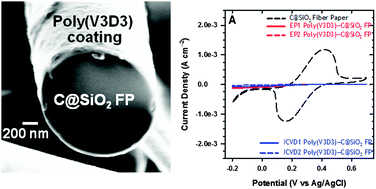Routes to 3D conformal solid-state dielectric polymers: electrodeposition versus initiated chemical vapor deposition†
Abstract
We show that two distinct methods, electropolymerization and initiated chemical vapour deposition (iCVD), can be adapted to generate ultrathin polymers (30–50 nm thick) at three dimensionally (3D) porous conductive substrates comprising ∼300 μm-thick carbon-coated silica fiber paper (C@SiO2). We selected 1,3,5-trivinyl-1,3,5-trimethylcyclotrisiloxane (“V3D3”) as a common monomer amenable to polymerization by either approach. Electroanalytical and electrical measurements confirm that all carbon surfaces are passivated with electronically insulating poly(V3D3) coatings.


 Please wait while we load your content...
Please wait while we load your content...